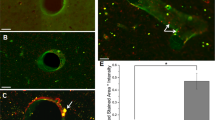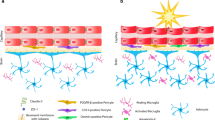Abstract
Introduction
Blast-induced neurotrauma (BINT) has been recognized as the common mode of traumatic brain injury amongst military and civilian personnel due to an increased insurgent activity domestically and abroad. Previous studies from this laboratory have identified three major pathological events following BINT which include blood brain barrier disruption the earliest event, followed by oxidative stress and neuroinflammation as secondary events occurring a few hours following blast.
Objectives
Our recent studies have also identified an increase in oxidative stress mediated by the activation of superoxide producing enzyme NADPH oxidase (NOX) in different brain regions at varying levels with neurons displaying higher oxidative stress (NOX activation) compared to any other neural cell. Since neurons have higher energy demands in brain and are more prone to oxidative damage, this study evaluated the effect of oxidative stress on blast-blast induced changes in metabolomics profiles in different brain regions.
Methods
Animals were exposed to mild/moderate blast injury (180 kPa) and examined the metabolites of energy metabolism, amino acid metabolism as well as the profiles of plasma membrane metabolites in different brain regions at different time points (24 h, 3 day and 7 day) after blast using 1H NMR spectroscopy. Effect of apocynin, an inhibitor of superoxide producing enzyme NADPH oxidase on cerebral metabalomics profiles was also examined.
Results
Several metabolomic profile changes were observed in frontal cortex and hippocampus with concomitant decrease in energy metabolism. In addition, glutamate/glutamine and other amino acid metabolism as well as metabolites involved in plasma membrane integrity were also altered. Hippocampus appears metabolically more vulnerable than the frontal cortex. A post-treatment of animals with apocynin, an inhibitor of NOX activation significantly prevented the changes in metabolite profiles.
Conclusion
Together these studies indicate that blast injury reduces both cerebral energy and neurotransmitter amino acid metabolism and that oxidative stress contributes to these processes. Thus, strategies aimed at reducing oxidative stress can have a therapeutic benefit in mitigating metabolic changes following BINT.




Similar content being viewed by others
References
Achanta, L. B., & Rae, C. D. (2017). beta-Hydroxybutyrate in the brain: One molecule, multiple mechanisms. Neurochemical Research,42, 35–49. https://doi.org/10.1007/s11064-016-2099-2.
Achanta, L. B., Rowlands, B. D., Thomas, D. S., Housley, G. D., & Rae, C. D. (2017). beta-Hydroxybutyrate boosts mitochondrial and neuronal metabolism but is not preferred over glucose under activated conditions. Neurochemical Research,42, 1710–1723. https://doi.org/10.1007/s11064-017-2228-6.
Amaral, A. I., Teixeira, A. P., Martens, S., Bernal, V., Sousa, M. F., & Alves, P. M. (2010). Metabolic alterations induced by ischemia in primary cultures of astrocytes: Merging 13C NMR spectroscopy and metabolic flux analysis. Journal of Neurochemistry,113, 735–748. https://doi.org/10.1111/j.1471-4159.2010.06636.x.
Arun, P., et al. (2013). Acute mitochondrial dysfunction after blast exposure: Potential role of mitochondrial glutamate oxaloacetate transaminase. Journal of Neurotrauma,30, 1645–1651. https://doi.org/10.1089/neu.2012.2834.
Bayir, H., Kochanek, P. M., & Kagan, V. E. (2006). Oxidative stress in immature brain after traumatic brain injury. Developmental Neuroscience,28, 420–431. https://doi.org/10.1159/000094168.
Bernini, A., et al. (2018). Modulation of cerebral ketone metabolism following traumatic brain injury in humans. Journal of Cerebral Blood Flow and Metabolism. https://doi.org/10.1177/0271678X18808947.
Chandra, N., Holmberg, A., & Feng, R. (2011). Controlling the shape of the shock wave profile in a blast facility. U.S. provisional patent application no. 61542354.
Cheema, A. K., et al. (2018a). Proteomic changes in mouse spleen after radiation-induced injury and its modulation by gamma-tocotrienol. Radiation Research,190, 449–463. https://doi.org/10.1667/RR15008.1.
Cheema, A. K., et al. (2018b). Plasma derived exosomal biomarkers of exposure to ionizing radiation in nonhuman primates. International Journal of Molecular Sciences,19, 3427. https://doi.org/10.3390/ijms19113427.
Choi, D. H., et al. (2014). NADPH oxidase 1, a novel molecular source of ROS in hippocampal neuronal death in vascular dementia. Antioxidants & Redox Signaling,21, 533–550. https://doi.org/10.1089/ars.2012.5129.
Cornelius, C., et al. (2013). Traumatic brain injury: Oxidative stress and neuroprotection. Antioxidants & Redox Signaling,19, 836–853. https://doi.org/10.1089/ars.2012.4981.
Dadas, A., Washington, J., Diaz-Arrastia, R., & Janigro, D. (2018). Biomarkers in traumatic brain injury (TBI): A review. Neuropsychiatric Disease and Treatment,14, 2989–3000. https://doi.org/10.2147/NDT.S125620.
Dang, D. K., et al. (2016). Apocynin prevents mitochondrial burdens, microglial activation, and pro-apoptosis induced by a toxic dose of methamphetamine in the striatum of mice via inhibition of p47phox activation by ERK. Journal of Neuroinflammation,13, 12. https://doi.org/10.1186/s12974-016-0478-x.
Dawaliby, R., et al. (2016). Phosphatidylethanolamine is a key regulator of membrane fluidity in eukaryotic cells. Journal of Biological Chemistry,291, 3658–3667. https://doi.org/10.1074/jbc.M115.706523.
de Lanerolle, N. C., Kim, J. H., & Bandak, F. A. (2015). Neuropathology of traumatic brain injury: Comparison of penetrating, nonpenetrating direct impact and explosive blast etiologies. Seminars in Neurology,35, 12–19. https://doi.org/10.1055/s-0035-1544240.
Feng, Y., et al. (2017). Protective role of apocynin via suppression of neuronal autophagy and TLR4/NF-kappaB signaling pathway in a rat model of traumatic brain injury. Neurochemical Research,42, 3296–3309. https://doi.org/10.1007/s11064-017-2372-z.
Fiandaca, M. S., Mapstone, M., Mehmoodi, A., Gross, T., Macciardi, F., Cheema, A., et al. (2018). Plasma metabolomic biomarkers accurately classify acute mild traumatic brain injury from controls. PLoS ONE,13, 4.
Flores, R. E., et al. (2018). Mycoplasma infection and hypoxia initiate succinate accumulation and release in the VM-M3 cancer cells. Biochimica et Biophysica Acta - Bioenergetics,1859, 975–983. https://doi.org/10.1016/j.bbabio.2018.03.012.
Gonzalez-Riano, C., Garcia, A., & Barbas, C. (2016). Metabolomics studies in brain tissue: A review. Journal of Pharmaceutical and Biomedical Analysis,130, 141–168. https://doi.org/10.1016/j.jpba.2016.07.008.
Hinkovska-Galcheva, V., Peeva, D., Momchilova-Pankova, A., Petkova, D., & Koumanov, K. (1988). Phosphatidylcholine and phosphatidylethanolamine derivatives, membrane fluidity and changes in the lipolytic activity of ram spermatozoa plasma membranes during cryoconservation. International Journal of Biochemistry,20, 867–871.
Hirata, F., & Axelrod, J. (1978). Enzymatic methylation of phosphatidylethanolamine increases erythrocyte membrane fluidity. Nature,275, 219–220.
Hoyer, S. (1993). Brain oxidative energy and related metabolism, neuronal stress, and Alzheimer’s disease: A speculative synthesis. Journal of Geriatric Psychiatry and Neurology,6, 3–13. https://doi.org/10.1177/002383099300600101.
Hui-guo, L., Kui, L., Yan-ning, Z., & Yong-jian, X. (2010). Apocynin attenuate spatial learning deficits and oxidative responses to intermittent hypoxia. Sleep Medicine,11, 205–212. https://doi.org/10.1016/j.sleep.2009.05.015.
Kacso, G., et al. (2016). Two transgenic mouse models for beta-subunit components of succinate-CoA ligase yielding pleiotropic metabolic alterations. The Biochemical Journal,473, 3463–3485. https://doi.org/10.1042/BCJ20160594.
Kapoor, M., Sharma, N., Sandhir, R., & Nehru, B. (2018). Effect of the NADPH oxidase inhibitor apocynin on ischemia-reperfusion hippocampus injury in rat brain. Biomedicine & Pharmacotherapy,97, 458–472. https://doi.org/10.1016/j.biopha.2017.10.123.
Koppula, S., Kumar, H., Kim, I. S., & Choi, D. K. (2012). Reactive oxygen species and inhibitors of inflammatory enzymes, NADPH oxidase, and iNOS in experimental models of Parkinson's disease. Mediators of Inflammation,2012, 823902. https://doi.org/10.1155/2012/823902.
Lewen, A., & Hillered, L. (1998). Involvement of reactive oxygen species in membrane phospholipid breakdown and energy perturbation after traumatic brain injury in the rat. Journal of Neurotrauma,15, 521–530.
Li, H., Yan, Z., Zhu, J., Yang, J., & He, J. (2011). Neuroprotective effects of resveratrol on ischemic injury mediated by improving brain energy metabolism and alleviating oxidative stress in rats. Neuropharmacology,60, 252–258. https://doi.org/10.1016/j.neuropharm.2010.09.005.
Li, Q., Deng, S., Ibarra, R. A., Anderson, V. E., Brunengraber, H., & Zhang, G. F. (2015). Multiple mass isotopomer tracing of acetyl-CoA metabolism in Langendorff-perfused rat hearts: Channeling of acetyl-CoA from pyruvate dehydrogenase to carnitine acetyltransferase. Journal of Biological Chemistry,290, 8121–8132. https://doi.org/10.1074/jbc.M114.631549.
Ling, G. S., et al. (2013). Traumatic brain injury in modern war. Current Opinion in Anesthesiology,24, 124–130.
Liu, X., et al. (2013). Effect of NADPH oxidase inhibitor apocynin on the expression of hypoxia-induced factor-1alpha and endothelin-1 in rat carotid body exposed to chronic intermittent hypoxia. Journal of Huazhong University of Science and Technology [Medical Sciences],33, 178–184. https://doi.org/10.1007/s11596-013-1093-z.
Mishra, V., Skotak, M., Schuetz, H., Heller, A., Haorah, J., & Chandra, N. (2016). Primary blast causes mild, moderate, severe and lethal TBI with increasing blast overpressures: Experimental rat injury model. Scientific Reports,6, 26992.
Moore, B. (2015). Blast injuries—A prehospital perspective. Australasian Journal of Paramedicine,4, 1.
Penny, J. E., Kukums, J. R., Tyrer, J. H., & Eadie, M. J. (1974). Selective vulnerability of the hippocampus to hypoxia: Cytophotometric studies of enzyme activity in single neurones. Proc Aust Assoc Neurol,11, 177–181.
Plaitakis, A., & Zaganas, I. (2001). Regulation of human glutamate dehydrogenases: Implications for glutamate, ammonia and energy metabolism in brain. Journal of Neuroscience Research,66, 899–908. https://doi.org/10.1002/jnr.10054.
Prins, M. L., & Giza, C. C. (2006). Induction of monocarboxylate transporter 2 expression and ketone transport following traumatic brain injury in juvenile and adult rats. Developmental Neuroscience,28, 447–456. https://doi.org/10.1159/000094170.
Prins, M. L., & Matsumoto, J. H. (2014). The collective therapeutic potential of cerebral ketone metabolism in traumatic brain injury. Journal of Lipid Research,55, 2450–2457. https://doi.org/10.1194/jlr.R046706.
Rama Rao, K. V., et al. (2018). A single primary blast-induced traumatic brain injury in rodent model causes cell-type dependent increase in NADPH oxidase isoforms in vulnerable brain regions. Journal of Neurotrauma. https://doi.org/10.1089/neu.2017.5358.
Rodriguez-Rodriguez, P., Almeida, A., & Bolanos, J. P. (2013). Brain energy metabolism in glutamate-receptor activation and excitotoxicity: Role for APC/C-Cdh1 in the balance glycolysis/pentose phosphate pathway. Neurochemistry International,62, 750–756. https://doi.org/10.1016/j.neuint.2013.02.005.
Schmidt-Kastner, R. (2015). Genomic approach to selective vulnerability of the hippocampus in brain ischemia-hypoxia. Neuroscience,309, 259–279. https://doi.org/10.1016/j.neuroscience.2015.08.034.
Skotak, M., & Chandra, N. (2016). Primary blast injury criteria for animal/human TBI models using field validated shock tubes (pp. 1–28). New Jersey Institute of Technology: Newark, NJ.
Sokoloff, L. (1992). Energy metabolism and effects of energy depletion or exposure to glutamate. Canadian Journal of Physiology and Pharmacology,70(Suppl), S107–S112.
Song, S. X., et al. (2013). Attenuation of brain edema and spatial learning deficits by the inhibition of NADPH oxidase activity using apocynin following diffuse traumatic brain injury in rats. Mol Med Rep,7, 327–331. https://doi.org/10.3892/mmr.2012.1147.
Stewart, J. D., & Bolt, H. M. (2011). Metabolomics: Biomarkers of disease and drug toxicity. Archives of Toxicology,85, 3–4. https://doi.org/10.1007/s00204-010-0635-4.
Tavazzi, B., et al. (2005). Cerebral oxidative stress and depression of energy metabolism correlate with severity of diffuse brain injury in rats. Neurosurgery,56, 582–589. https://doi.org/10.1227/01.neu.0000156715.04900.e6.
Tretter, L., Patocs, A., & Chinopoulos, C. (2016). Succinate, an intermediate in metabolism, signal transduction, ROS, hypoxia, and tumorigenesis. Biochimica et Biophysica Acta,1857, 1086–1101. https://doi.org/10.1016/j.bbabio.2016.03.012.
Turski, L., & Turski, W. A. (1993). Towards an understanding of the role of glutamate in neurodegenerative disorders: Energy metabolism and neuropathology. Experientia,49, 1064–1072.
van der Veen, J. N., Kennelly, J. P., Wan, S., Vance, J. E., Vance, D. E., & Jacobs, R. L. (2017). The critical role of phosphatidylcholine and phosphatidylethanolamine metabolism in health and disease. Biochimica et Biophysica Acta - Biomembranes,1859, 1558–1572. https://doi.org/10.1016/j.bbamem.2017.04.006.
Wallner, S., Orso, E., Grandl, M., Konovalova, T., Liebisch, G., & Schmitz, G. (2018). Phosphatidylcholine and phosphatidylethanolamine plasmalogens in lipid loaded human macrophages. PLoS ONE,13, e0205706. https://doi.org/10.1371/journal.pone.0205706.
Wolahan, S. M., et al. (2017). Influence of glycemic control on endogenous circulating ketone concentrations in adults following traumatic brain injury. Neurocritical Care,26, 239–246. https://doi.org/10.1007/s12028-016-0313-3.
Zhang, G. L., Dai, D. Z., Zhang, C., & Dai, Y. (2013). Apocynin and raisanberine alleviate intermittent hypoxia induced abnormal StAR and 3beta-HSD and low testosterone by suppressing endoplasmic reticulum stress and activated p66Shc in rat testes. Reproductive Toxicology,36, 60–70. https://doi.org/10.1016/j.reprotox.2012.12.002.
Acknowledgements
This work was supported by Army Medical Research and Materiel Command project Primary Blast Injury Criteria for Animal/Human TBI Models using Field Validated Shock Tube, Grant Number: 14059001 (PI: Namas Chandra) and Indo-U.S Joint DRDO and DoD project (US-IN-A-16–0002 on Experimental and Computational studies in Blunt and Blast induced Traumatic Injuries. PI: Raj Gupta).
Author information
Authors and Affiliations
Contributions
PR, KVR, RT wrote the main manuscript text, PR, KVR, AR and RT performed the experimental studies. All authors reviewed the manuscript.
Corresponding authors
Ethics declarations
Conflict of interest
The authors declare no conflicts of interests.
Ethics approval
This study utilized rodents. All animal studies conducted in the manuscript were approved by the Newark Institute of Animal Care and Use Committee (File No. 1605A1E1019) and Animal Welfare and Ethical Review Committee at the Rutgers University.
Additional information
Publisher's Note
Springer Nature remains neutral with regard to jurisdictional claims in published maps and institutional affiliations.
Electronic supplementary material
Below is the link to the electronic supplementary material.
Rights and permissions
About this article
Cite this article
Rana, P., Rama Rao, K.V., Ravula, A. et al. Oxidative stress contributes to cerebral metabolomic profile changes in animal model of blast-induced traumatic brain injury. Metabolomics 16, 39 (2020). https://doi.org/10.1007/s11306-020-1649-4
Received:
Accepted:
Published:
DOI: https://doi.org/10.1007/s11306-020-1649-4




